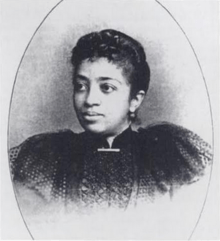Joan Imogen Howard

Joan Imogen Howard (also Joan Imogene Howard; born 1851) was an American educator and principal from the U.S. state of Massachusetts. Characterized as a "black liberal integrationist",[1] she was the first African American graduate of Girls High and Normal School in Boston,[2] as well as the only African American to serve on a state board for the Columbian Exposition.[3]
Early years and education
Joan Imogen Howard, was born in Boston in 1851 (November 1850 is also mentioned).[4] Her father, Edwin Frederick Howard, was a well-known citizen of that city, and her mother, Joan Louise Turpin Howard, was a native of New York. She had one sister, Adeline Turpin Howard, the principal of the Wormley School, Washington, D. C., and one brother, Edwin Clarence Joseph Turpin Howard, M. D., the first African American graduate of Harvard Medical School,[2] and a prominent physician in Philadelphia.[5] She was a cousin of the well-known elocutionist, Ednorah Nahar.[6]
At the age of 14, she graduated from the Wells Grammar School, Blossom Street, Boston, one of ten honor pupils who received silver medals. Her parents encouraged her to pursue a higher course of instruction, and consequently, after a successful entrance examination, she became a student of the Girls' High and Normal School, as it was then called. She was the first African American women to enter, and after a three years' course, to graduate from this, which was, at that time, the highest institution of learning in Boston.[5]
Career
A situation as an assistant teacher in Colored Grammar School No. 4, later Grammar School No. 81, was immediately offered. For several years an evening school, which was largely attended and of which she was principal, was carried on in the same building. Later, she took a course in “Methods of Instruction” at the Saturday sessions of the Normal College of New York City, receiving a Master of Arts diploma from this institution (1877). In 1892, she received the degree of Master of Pedagogy at the University of the City of New York. She held a special position on the Board of Women Managers of the State of New York for the Columbian Exposition, one of five of the Committee on Education.[5]
References
- ↑ Robinson 2012, p. 76.
- 1 2 Powell 2000, p. 307.
- ↑ Wells-Barnett & Rydell 1893, p. xviii.
- ↑ Dorman 1998, p. 151.
- 1 2 3 Scruggs 1893, p. 156-58.
- ↑ Majors 1893, p. 244.
Attribution
 This article incorporates text from a work in the public domain: L. A. Scruggs' Women of Distinction: Remarkable in Works and Invincible in Character (1893)
This article incorporates text from a work in the public domain: L. A. Scruggs' Women of Distinction: Remarkable in Works and Invincible in Character (1893)
Bibliography
- Dorman, Franklin A. (1 June 1998). Twenty families of color in Massachusetts: 1742-1998. New England Historic Genealogical Society. ISBN 978-0-88082-077-6.
- Majors, Monroe A. (1893). Noted Negro women, their triumphs and activities (Reprint 1971 by Freeport, New York: Books for Libraries Press ed.). Chicago, Illinois: Donohue and Henneberry. ISBN 0-8369-8733-0.
- Powell, William S. (9 November 2000). Dictionary of North Carolina Biography: Vol. 5, P-S. University of North Carolina Press. ISBN 978-0-8078-6700-6.
- Robinson, Cedric J. (1 September 2012). Forgeries of Memory and Meaning: Blacks and the Regimes of Race in American Theater and Film before World War II. University of North Carolina Press Books. ISBN 978-1-4696-0675-0.
- Scruggs, Lawson Andrew (1893). Women of Distinction: Remarkable in Works and Invincible in Character (Public domain ed.). L. A. Scruggs.
- Wells-Barnett, Ida B.; Rydell, Robert W. (1893). The Reason why the Colored American is Not in the World's Columbian Exposition: The Afro-American's Contribution to Columbian Literature (Public domain ed.). University of Illinois Press. ISBN 978-0-252-06784-6.